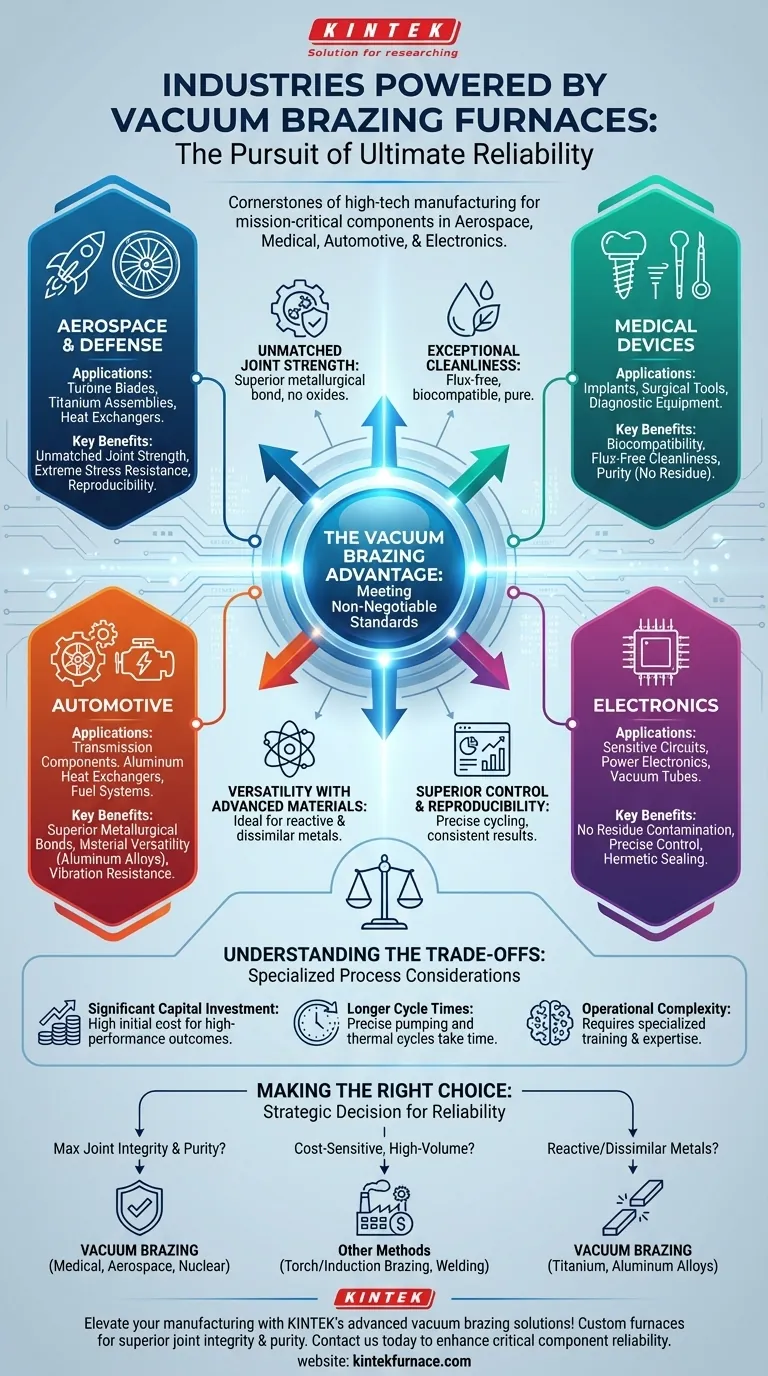In short, vacuum brazing furnaces are cornerstones of high-technology manufacturing, used extensively in the aerospace, medical, automotive, and electronics industries. These sectors rely on the process for creating components where failure is not an option, leveraging its ability to produce exceptionally strong, pure, and uniform joints between advanced metals.
The critical takeaway is that an industry’s use of vacuum brazing is driven by a need for ultimate reliability. The process is chosen not just for joining parts, but for guaranteeing the metallurgical integrity of mission-critical components in a pristine, controlled environment.
Why These Industries Rely on Vacuum Brazing
The adoption of vacuum brazing is not about preference; it's about meeting non-negotiable performance standards. The physics of the vacuum environment provides benefits that other joining methods cannot consistently deliver.
Unmatched Joint Strength and Integrity
In a vacuum, there is no oxygen or other atmospheric gas to contaminate the joint. This prevents the formation of oxides during heating, allowing the brazing filler metal to flow freely and create a superior metallurgical bond.
This level of strength is essential for parts like aerospace turbine blades and automotive transmission components that are subjected to extreme stress and vibration.
Exceptional Cleanliness and Purity
Vacuum brazing is a flux-free process. Flux is a chemical agent used in traditional brazing to clean the metal surfaces, but its residue can cause corrosion or contamination.
For medical devices like implants and surgical tools, the absence of flux is critical for ensuring biocompatibility and preventing adverse reactions. In electronics, it ensures that no residue interferes with sensitive circuits.
Superior Control and Reproducibility
Modern vacuum furnaces offer incredibly precise control over heating and cooling cycles. This programmability ensures that every part is processed under the exact same conditions.
This reproducibility is vital for aerospace, defense, and automotive manufacturing, where thousands of identical components must meet stringent quality standards without deviation.
Versatility with Advanced Materials
Many advanced industries work with reactive or dissimilar metals. The controlled, inert environment of a vacuum furnace is ideal for brazing materials like aluminum alloys, stainless steel, and titanium.
This makes it the go-to process for manufacturing lightweight aluminum heat exchangers for the automotive sector or complex titanium assemblies for aerospace applications.
Understanding the Trade-offs
While powerful, vacuum brazing is a specialized process with specific considerations. It is not the universal solution for all metal joining needs.
Significant Capital Investment
Vacuum furnaces are complex machines that represent a high initial cost compared to standard atmospheric furnaces or welding equipment. The investment is typically justified only by the need for high-performance outcomes.
Longer Cycle Times
The process involves pumping down the chamber to a vacuum, running a precise thermal cycle, and controlled cooling. This can result in longer overall processing times per batch compared to other, less controlled methods.
Operational Complexity
Operating and maintaining a vacuum furnace requires specialized training and skilled technicians. The process demands a deep understanding of metallurgy, vacuum technology, and thermal dynamics.
Making the Right Choice for Your Application
Selecting vacuum brazing depends entirely on the performance requirements and material constraints of your project.
- If your primary focus is maximum joint integrity and purity: For medical, aerospace, or nuclear components where failure could be catastrophic, vacuum brazing is the definitive choice.
- If your primary focus is cost-sensitive, high-volume production: For less critical parts made from common steels, other methods like torch brazing, induction brazing, or welding may be more economical.
- If your primary focus is joining reactive or dissimilar metals: For materials like titanium, refractory metals, or specific aluminum alloys, vacuum brazing is often the only reliable method to achieve a clean, strong bond.
Ultimately, choosing vacuum brazing is a strategic decision to prioritize quality, reliability, and performance above all else.
Summary Table:
| Industry | Key Applications | Primary Benefits |
|---|---|---|
| Aerospace | Turbine blades, titanium assemblies | Unmatched joint strength, purity, and reproducibility |
| Medical | Implants, surgical tools | Biocompatibility, flux-free cleanliness |
| Automotive | Transmission components, heat exchangers | Superior metallurgical bonds, material versatility |
| Electronics | Sensitive circuits | No residue contamination, precise control |
Elevate your manufacturing with KINTEK's advanced vacuum brazing solutions! Leveraging exceptional R&D and in-house manufacturing, we provide diverse laboratories and industries with reliable high-temperature furnace systems, including Muffle, Tube, Rotary, Vacuum & Atmosphere Furnaces, and CVD/PECVD Systems. Our strong deep customization capability ensures we precisely meet your unique experimental and production needs for superior joint integrity and purity. Contact us today to discuss how we can enhance your critical component reliability!
Visual Guide

Related Products
- Molybdenum Vacuum Heat Treat Furnace
- Multi Zone Laboratory Quartz Tube Furnace Tubular Furnace
- Laboratory Muffle Oven Furnace with Bottom Lifting
- High Pressure Laboratory Vacuum Tube Furnace Quartz Tubular Furnace
- 1700℃ Controlled Inert Nitrogen Atmosphere Furnace
People Also Ask
- Why should nitrogen not be used as a cooling gas for titanium alloys in vacuum heat treatment? Avoid Catastrophic Failures
- What does a vacuum furnace do? Achieve Superior Material Processing in a Pure Environment
- What is a vacuum furnace and what processes can it perform? Unlock Precision Heat Treatment Solutions
- What are the main functions of vacuum furnaces? Achieve Superior Purity and Control in High-Temperature Processes
- What does the vacuum system of a vacuum furnace consist of? Essential Components for Clean Heat Processing



















